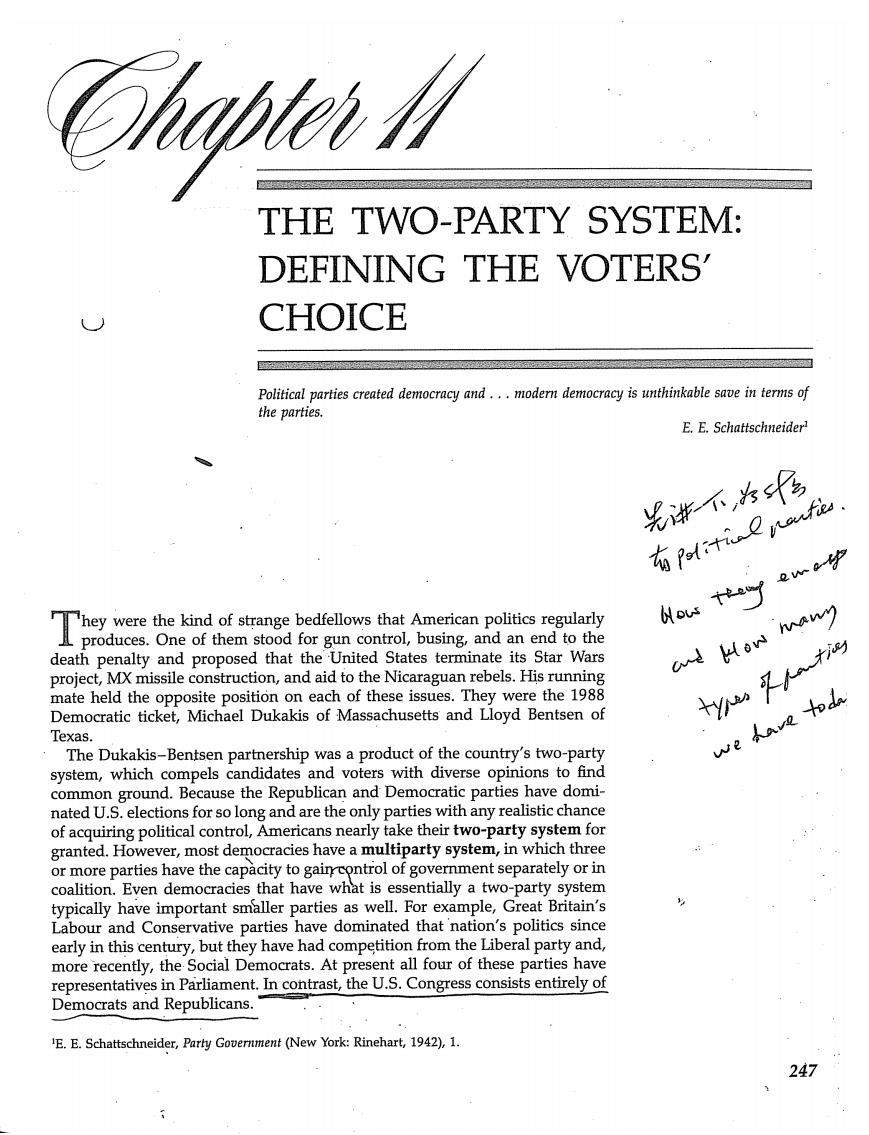
(hg从 THE TWO-PARTY SYSTEM: DEFINING THE VOTERS CHOICE Political parties created democracy and...modern democracy is unthinkable save in terms of the parties. E.E.Schattschneider 光不,片 有politi巴uf品 poduc ne e inn 从est death penalty and proposed that the United States terminate its Star Wars 是Hoy project,MX missile construction,and aid to the Nicaraguan rebels.His running mate held the opposite position on each of these issues.They were the 1988 Democratic ticket,Michael Dukakis of Massachusetts and Lloyd Bentsen of w平测 Texas. The Dukakis-Bentsen partnership was a product of the country's two-party we lave toda system,which compels candidates and voters with diverse opinions to find common ground.Because the Republican and Democratic parties have domi- nated U.S.elections for so long and are the only parties with any realistic chance of acquiring political control,Americans nearly take their two-party system for granted.However,most democracies have a multiparty system,in which three or more parties have the capacity to gaircontrol of government separately or in coalition.Even democracies that have what is essentially a two-party system typically have important smaller parties as well.For example,Great Britain's Labour and Conservative parties have dominated that nation's politics since early in this century,but they have had competition from the Liberal party and, more recently,the Social Democrats.At present all four of these parties have representatives in Parliament.In contrast,the U.S.Congress consists entirely of Democrats and Republicans. E.E.Schattschneider,Party Government (New York:Rinehart,1942),1. 247
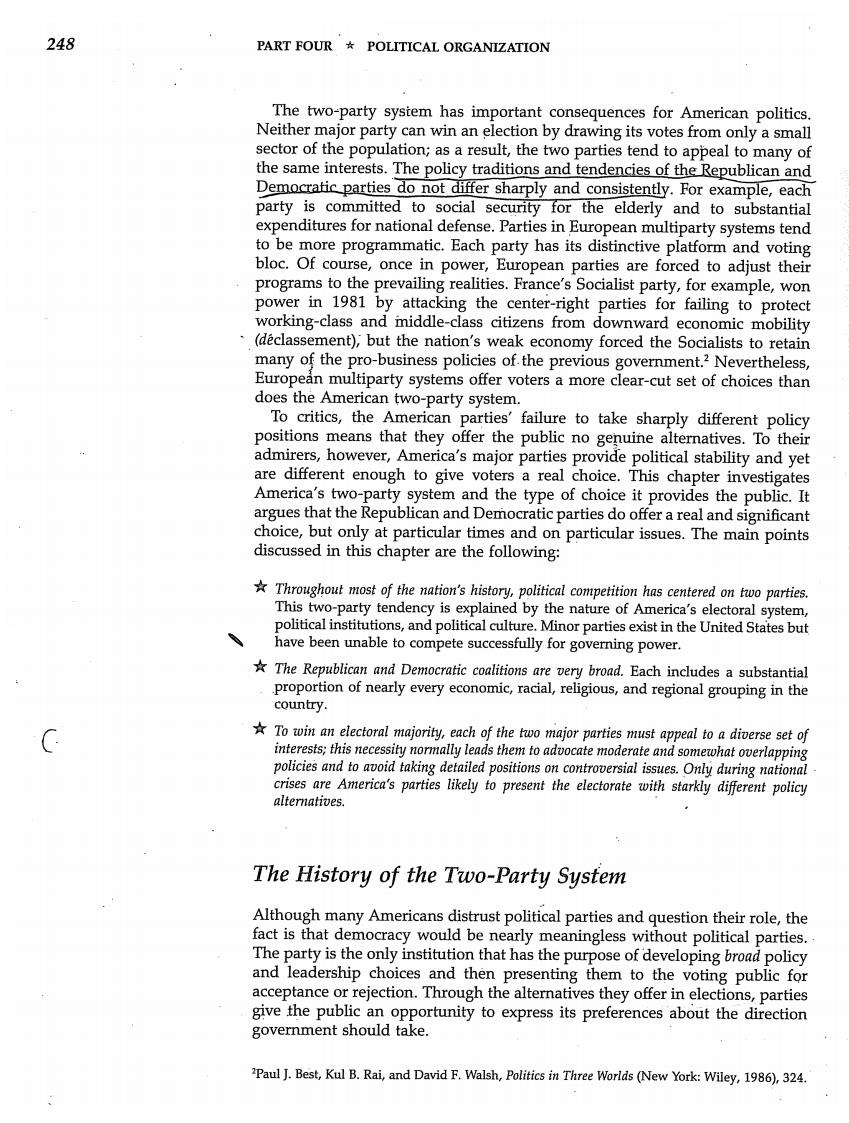
248 PART FOUR POLITICAL ORGANIZATION The two-party system has important consequences for American politics Neither major party can win an election by drawing its votes from only a small sector of the population;as a result,the two parties tend to appeal to many of the same interests.The policy traditions and tendencies of the Republican and Democratic parties do not differ sharply and consistently.For example,each party is committed to social security for the elderly and to substantial expenditures for national defense.Parties in European multiparty systems tend to be more programmatic.Each party has its distinctive platform and voting bloc.Of course,once in power,European parties are forced to adjust their programs to the prevailing realities.France's Socialist party,for example,won power in 1981 by attacking the center-right parties for failing to protect working-class and mniddle-class citizens from downward economic mobility (declassement),but the nation's weak economy forced the Socialists to retain many of the pro-business policies of the previous government.2 Nevertheless, European multiparty systems offer voters a more clear-cut set of choices than does the American two-party system. To critics,the American parties'failure to take sharply different policy positions means that they offer the public no genuine alternatives.To their admirers,however,America's major parties provide political stability and yet are different enough to give voters a real choice.This chapter investigates America's two-party system and the type of choice it provides the public.It argues that the Republican and Democratic parties do offer a real and significant choice,but only at particular times and on particular issues.The main points discussed in this chapter are the following: *Throughout most of the nation's history,political competition has centered on two parties. This two-party tendency is explained by the nature of America's electoral system, political institutions,and political culture.Minor parties exist in the United States but have been unable to compete successfully for governing power. The Republican and Democratic coalitions are very broad.Each includes a substantial proportion of nearly every economic,racial,religious,and regional grouping in the country. C To win an electoral majority,each of the two major parties must appeal to a diverse set of interests;this necessity normally leads them to advocate moderate and somewhat overlapping policies and to avoid taking detailed positions on controversial issues.Only during national crises are America's parties likely to present the electorate with starkly different policy alternatives. The History of the Two-Party System Although many Americans distrust political parties and question their role,the fact is that democracy would be nearly meaningless without political parties. The party is the only institution that has the purpose of developing broad policy and leadership choices and then presenting them to the voting public for acceptance or rejection.Through the alternatives they offer in elections,parties give the public an opportunity to express its preferences about the direction government should take. Paul J.Best,Kul B.Rai,and David F.Walsh,Politics in Three Worlds (New York:Wiley,1986),324
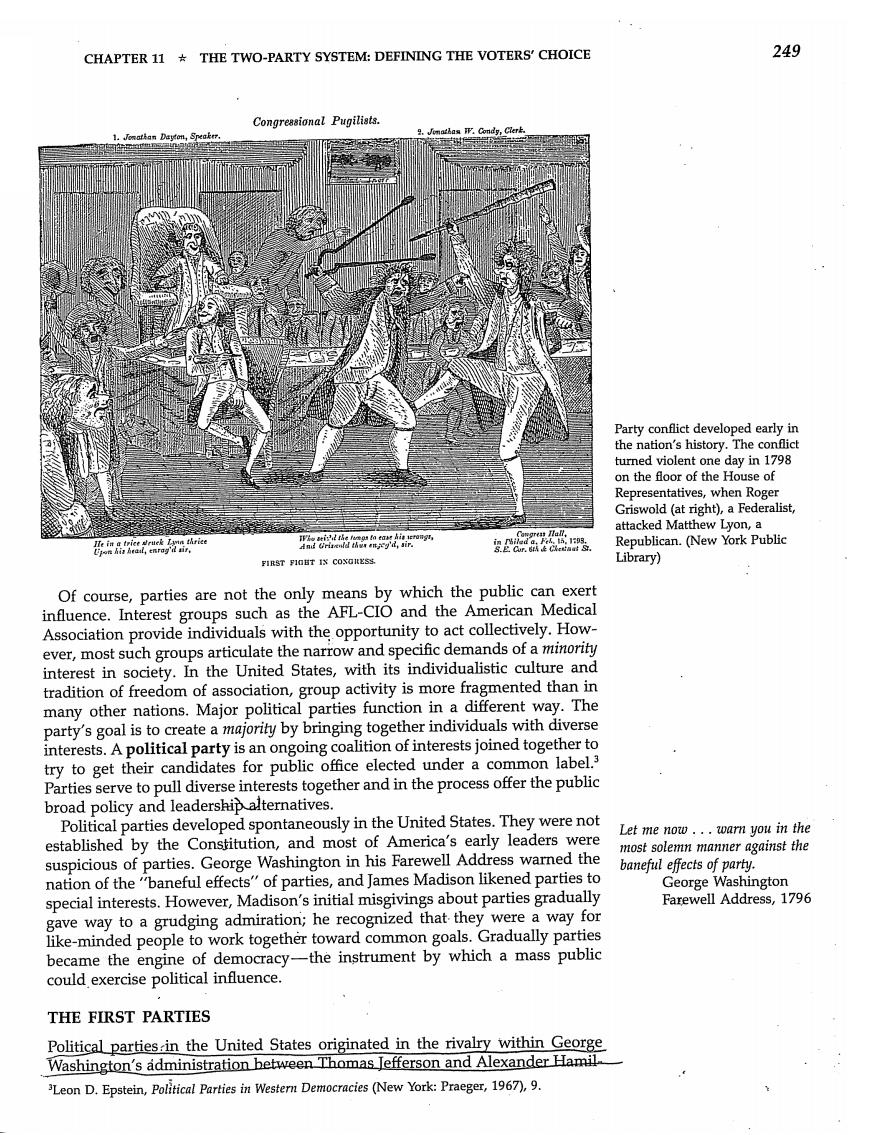
CHAPTER 11 THE TWO-PARTY SYSTEM:DEFINING THE VOTERS'CHOICE 249 Congreasional Pugilists. Party conflict developed early in the nation's history.The conflict turned violent one day in 1798 on the floor of the House of Representatives,when Roger Griswold(at right),a Federalist, attacked Matthew Lyon,a 你和品aa…ia: nr 器器 Republican.(New York Public FIRST FIOBT IX COXORESS Library) Of course,parties are not the only means by which the public can exert influence.Interest groups such as the AFL-CIO and the American Medical Association provide individuals with the opportunity to act collectively.How- ever,most such groups articulate the narrow and specific demands of a minority interest in society.In the United States,with its individualistic culture and tradition of freedom of association,group activity is more fragmented than in many other nations.Major political parties function in a different way.The party's goal is to create a majority by bringing together individuals with diverse interests.A political party is an ongoing coalition of interests joined together to try to get their candidates for public office elected under a common label.3 Parties serve to pull diverse interests together and in the process offer the public broad policy and leadership alternatives. Political parties developed spontaneously in the United States.They were not Let me now...warn you in the established by the Constitution,and most of America's early leaders were most solemn manner against the suspicious of parties.George Washington in his Farewell Address warned the baneful effects of party. nation of the"baneful effects"of parties,and James Madison likened parties to George Washington special interests.However,Madison's initial misgivings about parties gradually Farewell Address,1796 gave way to a grudging admiration;he recognized that they were a way for like-minded people to work together toward common goals.Gradually parties became the engine of democracy-the instrument by which a mass public could exercise political influence. THE FIRST PARTIES Political parties in the United States originated in the rivalry within George Washington's administration between Thomas Jefferson and Alexander Hamil Leon D.Epstein,Political Parties in Western Democracies (New York:Praeger,1967),9
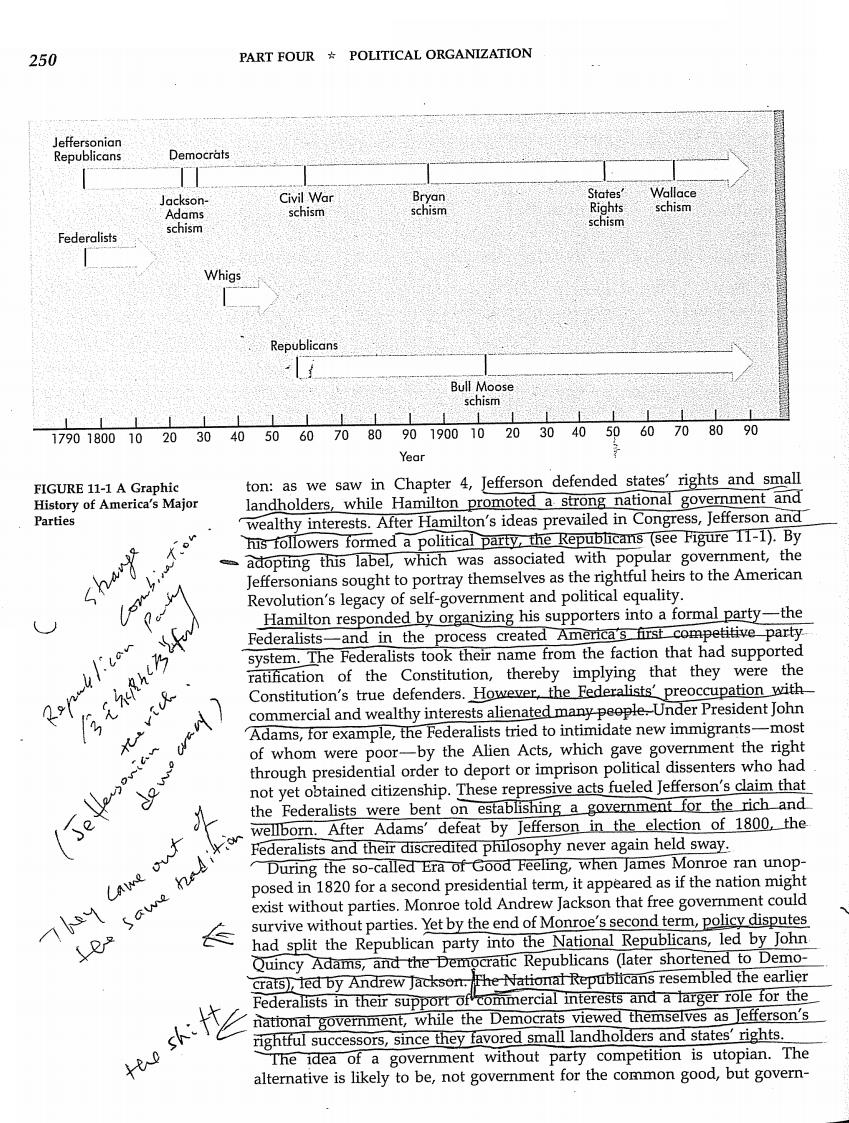
250 PART FOUR POLITICAL ORGANIZATION Jeffersonian Republicans Democrats Civil War Bryan States' Wallace Jackson- schism schism Rights schism Adams schism schism Federalists Whigs Republicans Bull Moose schism 1790180010 20304050607080901900102030405060708090 Year FIGURE 11-1 A Graphic ton:as we saw in Chapter 4,Jefferson defended states'rights and small History of America's Major landholders,while Hamilton promoted a strong national government and Parties wealthy interests.After Hamilton's ideas prevailed in Congress,Jefferson and his followers formed a political party,the Republicans (see Figure 11-1).By adopting this label,which was associated with popular government,the Jeffersonians sought to portray themselves as the rightful heirs to the American Revolution's legacy of self-government and political equality. Hamilton responded by organizing his supporters into a formal party-the Federalists-and in the process created America's first competitive party system.The Federalists took their name from the faction that had supported ratification of the Constitution,thereby implying that they were the Constitution's true defenders.However,the Federalists'preoccupation with commercial and wealthy interests alienated many people.Under President John Adams,for example,the Federalists tried to intimidate new immigrants-most of whom were poor-by the Alien Acts,which gave government the right through presidential order to deport or imprison political dissenters who had not yet obtained citizenship.These repressive acts fueled Jefferson's claim that the Federalists were bent on establishing a government for the rich and wellborn.After Adams'defeat by Jefferson in the election of 1800,the Federalists and their discredited philosophy never again held sway. During the so-called Era of Good Feeling,when James Monroe ran unop- 乙Ae posed in 1820 for a second presidential term,it appeared as if the nation might exist without parties.Monroe told Andrew Jackson that free government could survive without parties.Yet by the end of Monroe's second term,policy disputes (eR had split the Republican party into the National Republicans,led by John Quincy Adams,and the Democratic Republicans (later shortened to Demo- crats),led by Andrew Jackson. The National Republicans resembled the earlier Federalists in their support of commercial interests and a larger role for the national government,while the Democrats viewed themselves as Jefferson's rightful successors,since they favored small landholders and states'rights. The idea of a government without party competition is utopian.The alternative is likely to be,not government for the common good,but govern-
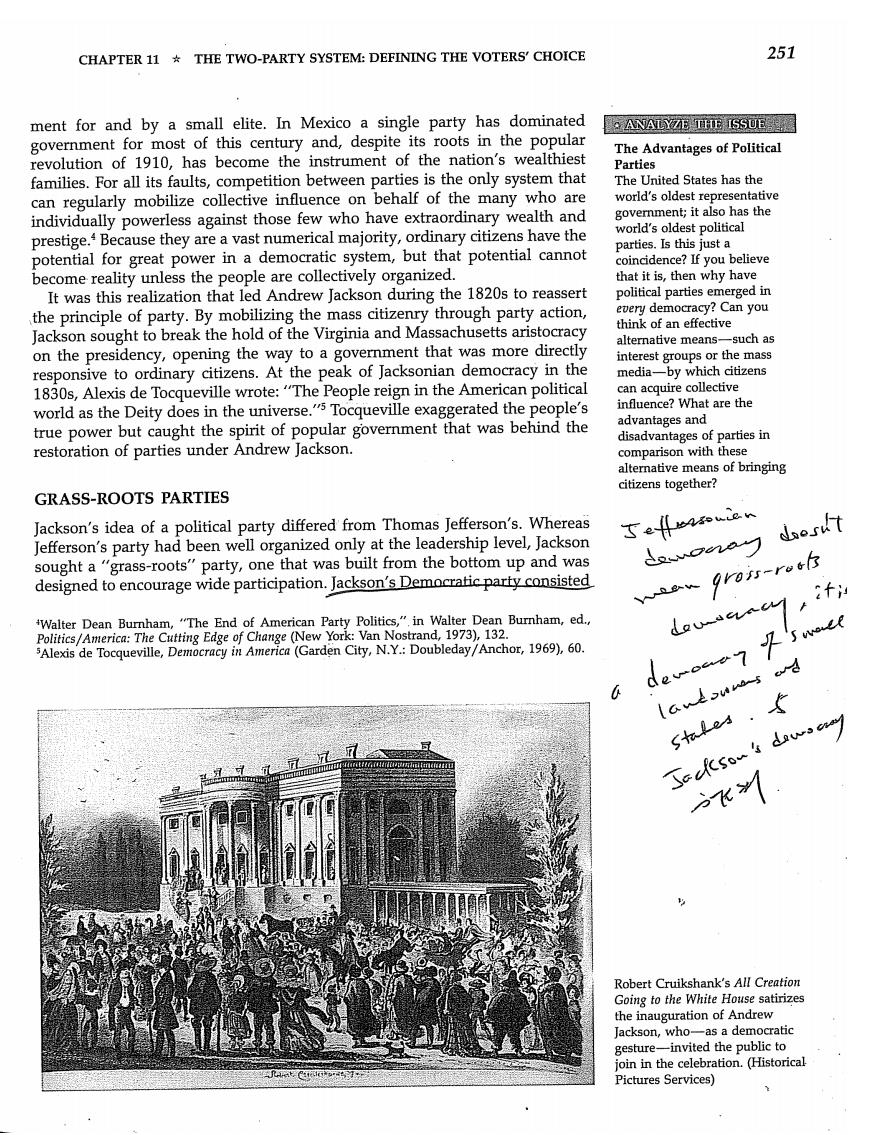
CHAPTER 11 THE TWO-PARTY SYSTEM:DEFINING THE VOTERS'CHOICE 251 ment for and by a small elite.In Mexico a single party has dominated ANALYZE THE1SSUE覆 government for most of this century and,despite its roots in the popular The Advantages of Political revolution of 1910,has become the instrument of the nation's wealthiest Parties families.For all its faults,competition between parties is the only system that The United States has the can regularly mobilize collective influence on behalf of the many who are world's oldest representative individually powerless against those few who have extraordinary wealth and government;it also has the prestige.Because they are a vast numerical majority,ordinary citizens have the world's oldest political potential for great power in a democratic system,but that potential cannot parties.Is this just a coincidence?If you believe become reality unless the people are collectively organized. that it is,then why have It was this realization that led Andrew Jackson during the 1820s to reassert political parties emerged in the principle of party.By mobilizing the mass citizenry through party action, every democracy?Can you Jackson sought to break the hold of the Virginia and Massachusetts aristocracy think of an effective alternative means-such as on the presidency,opening the way to a government that was more directly interest groups or the mass responsive to ordinary citizens.At the peak of Jacksonian democracy in the media-by which citizens 1830s,Alexis de Tocqueville wrote:"The People reign in the American political can acquire collective world as the Deity does in the universe."Tocqueville exaggerated the people's influence?What are the true power but caught the spirit of popular government that was behind the advantages and disadvantages of parties in restoration of parties under Andrew Jackson. comparison with these alternative means of bringing citizens together? GRASS-ROOTS PARTIES Jackson's idea of a political party differed from Thomas Jefferson's.Whereas Jefferson's party had been well organized only at the leadership level,Jackson sought a"grass-roots"party,one that was built from the bottom up and was designed to encourage wide participation.Jackson's Democratic party consisted Walter Dean Burnham,"The End of American Party Politics,".in Walter Dean Burnham,ed., Politics/America:The Cutting Edge of Change (New York:Van Nostrand,1973),132. SAlexis de Tocqueville,Democracy in America(Garden City,N.Y.:Doubleday/Anchor,1969),60. d Stules Robert Cruikshank's All Creation Going to the White House satirizes the inauguration of Andrew Jackson,who-as a democratic gesture-invited the public to join in the celebration.(Historical Pictures Services)
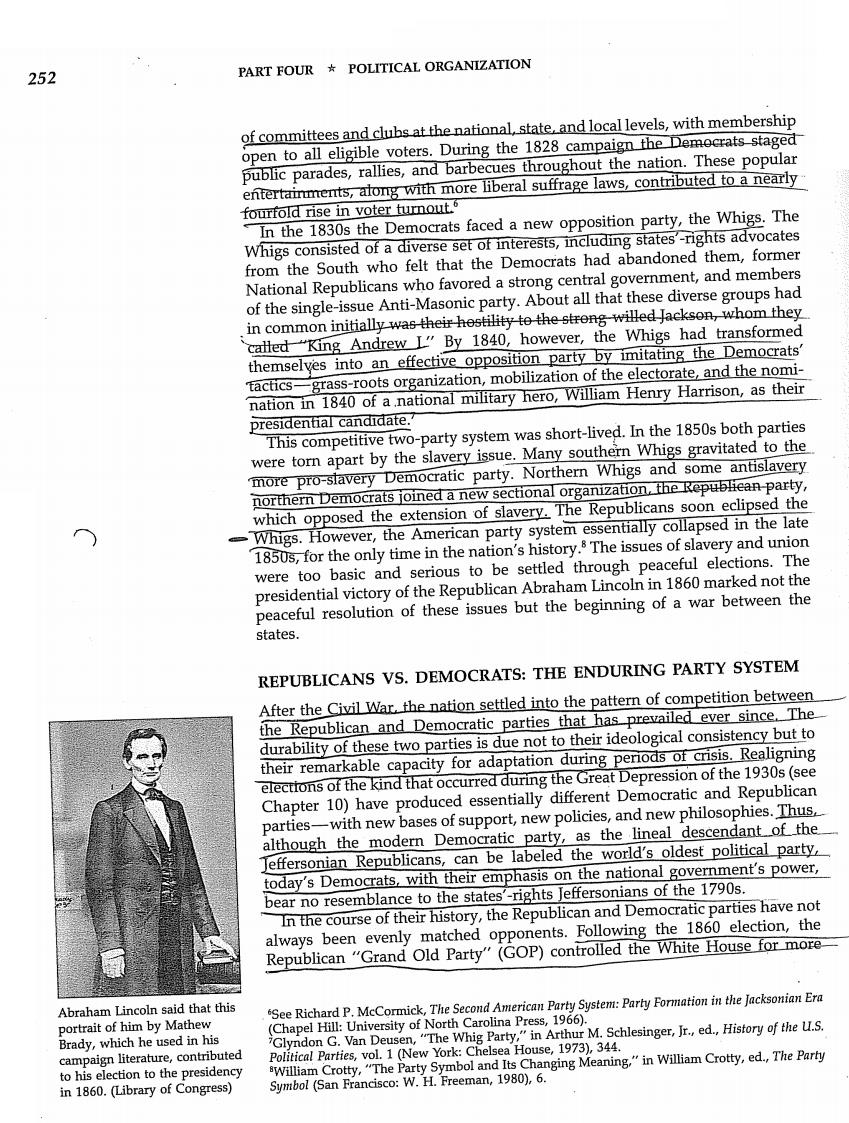
252 PART FOUR POLITICAL ORGANIZATION of committees and clubs at the national,state,and local levels,with membership open to all eligible voters.During the 1828 campaign the Demecrats staged public parades,rallies,and barbecues throughout the nation.These popular entertainments,along with more liberal suffrage laws,contributed to a nearly fourfold rise in voter turnout In the 1830s the Democrats faced a new opposition party,the Whigs.The Whigs consisted of a diverse set of interests,including states'-rights advocates from the South who felt that the Democrats had abandoned them,former National Republicans who favored a strong central government,and members of the single-issue Anti-Masonic party.About all that these diverse groups had in common initially was their hestility to the strong willed Jackson,whom they called "King Andrew L"'By 1840,however,the Whigs had transformed themselves into an effective opposition party by imitating the Democrats' tactics-grass-roots organization,mobilization of the electorate,and the nomi- nation in 1840 of a .national military hero,William Henry Harrison,as their presidential candidate.' This competitive two-party system was short-lived.In the 1850s both parties were torn apart by the slavery issue.Many southern Whigs gravitated to the more pro-slavery Democratic party.Northern Whigs and some antislavery northern Democrats joined a new sectional organization,the Republean party, which opposed the extension of slavery.The Republicans soon eclipsed the Whigs.However,the American party system essentially collapsed in the late 1850s,for the only time in the nation's history.The issues of slavery and union were too basic and serious to be settled through peaceful elections.The presidential victory of the Republican Abraham Lincoln in 1860 marked not the peaceful resolution of these issues but the beginning of a war between the states. REPUBLICANS VS.DEMOCRATS:THE ENDURING PARTY SYSTEM After the Civil War,the nation settled into the pattern of competition between the Republican and Democratic parties that has prevailed ever since.The durability of these two parties is due not to their ideological consistency but to their remarkable capacity for adaptation during periods of crisis.Realigning elections of the kind that occurred during the Great Depression of the 1930s(see Chapter 10)have produced essentially different Democratic and Republican parties-with new bases of support,new policies,and new philosophies.Thus. although the modern Democratic party,as the lineal descendant of the Jeffersonian Republicans,can be labeled the world's oldest political party, today's Democrats,with their emphasis on the national government's power, bear no resemblance to the states'-rights Jeffersonians of the 1790s. In the course of their history,the Republican and Democratic parties have not always been evenly matched opponents.Following the 1860 election,the Republican "Grand Old Party"(GOP)controlled the White House for more Abraham Lincoln said that this See Richard P.McCormick,The Second American Party System:Party Formation in the Jacksonian Era portrait of him by Mathew (Chapel Hill:University of North Carolina Press,1966). Brady,which he used in his Glyndon G.Van Deusen,"The Whig Party,"in Arthur M.Schlesinger,Jr.,ed.,History of the U.S. campaign literature,contributed Political Parties,vol.1(New York:Chelsea House,1973),344. to his election to the presidency William Crotty,"The Party Symbol and Its Changing Meaning,"in William Crotty,ed.,The Party in 1860.(Library of Congress) Symbol (San Francisco:W.H.Freeman,1980),6

CHAPTER 11 THE TWO-PARTY SYSTEM:DEFINING THE VOTERS'CHOICE 253 Moine N.H Wash. Montana N.D. Minn. Oregon Mich. Wyo lowa Nebraska Ohio nd Mo. Tenn. Okla. New Mexico 月a. Democrats control both houses FIGURE 11-2 Party Control of State Legislatures,1989 Republicans control both houses Intense party competition is not found in most states.Source: No party controls both houses Congressional Quarterly Weekly Report,November 12,1988,2893, Nonpartisan unicameral 3299-3300. than seventy years,losing it during this period to only two Democrats,Grover Cleveland and Woodrow Wilson,each of whom was assisted by dissension within Republican ranks.Cleveland won in 1884 when the GOP denied nomination to its own incumbent,Chester A.Arthur,and turned instead to James G.Blaine ("the Man from Maine),who,it appears,had the support neither of progressive Republicans nor of his own running mate,John A.Logan. In 1912 Wilson won when the Republicans were split by the Bull Moose party candidacy of Theodore Roosevelt.Without these internal problems,the Repub- licans might have held the presidency without interruption from the Civil War to the Depression. Franklin D.Roosevelt's election in 1932 began a twenty-year period of Democratic presidencies,but since the early 1950s the two parties have divided control of the White House.In 1960,1968,and 1976,the margin of victory for either party's presidential candidate was a slender 3 percent or less.As for the legislative branch,the Democrats have dominated Congress since 1930,losing control of both House and Senate only in 1947-1948 and 1953-1954,and of the Senate in 1980-1986. On the state and local levels,intense two-party competition is not the norm. In most states,for example,both houses of the legislature are controlled by the same party(see Figure 11-2).Party dominance tends to follow regional lines. Since the Civil War,Democrats have held sway over southern politics-the South's revenge on the party of Lincoln;only in recent decades has the region begun to see more party competition.The Republican party also has its traditional strongholds,such as New England and the rural Midwest,although Democratic candidates have recently improved their showing in these areas.As
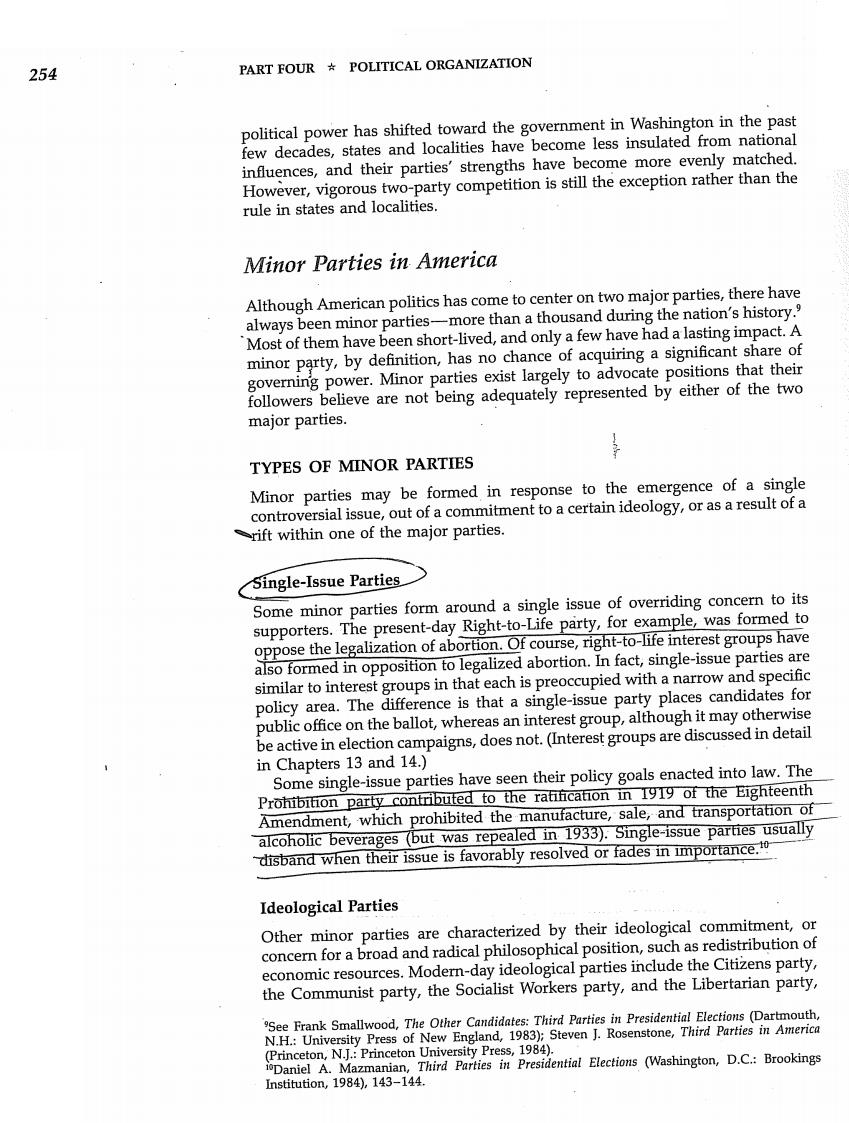
254 PART FOUR POLITICAL ORGANIZATION political power has shifted toward the government in Washington in the past few decades,states and localities have become less insulated from national influences,and their parties'strengths have become more evenly matched. However,vigorous two-party competition is still the exception rather than the rule in states and localities. Minor Parties in America Although American politics has come to center on two major parties,there have always been minor parties-more than a thousand during the nation's history. Most of them have been short-lived,and only a few have had a lasting impact.A minor party,by definition,has no chance of acquiring a significant share of governing power.Minor parties exist largely to advocate positions that their followers believe are not being adequately represented by either of the two major parties. TYPES OF MINOR PARTIES Minor parties may be formed in response to the emergence of a single controversial issue,out of a commitment to a certain ideology,or as a result of a rift within one of the major parties. Single-Issue Parties Some minor parties form around a single issue of overriding concern to its supporters.The present-day Right-to-Life party,for example,was formed to oppose the legalization of abortion.Of course,right-to-life interest groups have also formed in opposition to legalized abortion.In fact,single-issue parties are similar to interest groups in that each is preoccupied with a narrow and specific policy area.The difference is that a single-issue party places candidates for public office on the ballot,whereas an interest group,although it may otherwise be active in election campaigns,does not.(Interest groups are discussed in detail in Chapters 13 and 14.) Some single-issue parties have seen their policy goals enacted into law.The Prohibition party contributed to the ratification in 1919 of the Eighteenth Amendment,which prohibited the manufacture,sale,and transportation of alcoholic beverages (but was repealed in 1933).Single-issue parties usually disband when their issue is favorably resolved or fades in importance. Ideological Parties Other minor parties are characterized by their ideological commitment,or concern for a broad and radical philosophical position,such as redistribution of economic resources.Modern-day ideological parties include the Citizens party, the Communist party,the Socialist Workers party,and the Libertarian party, See Frank Smallwood,The Other Candidates:Third Parties in Presidential Elections(Dartmouth, N.H.:University Press of New England,1983);Steven J.Rosenstone,Third Parties in America (Princeton,N.J.:Princeton University Press,1984). 1Daniel A.Mazmanian,Third Parties in Presidential Elections (Washington,D.C.:Brookings nstitution,1984),143-144
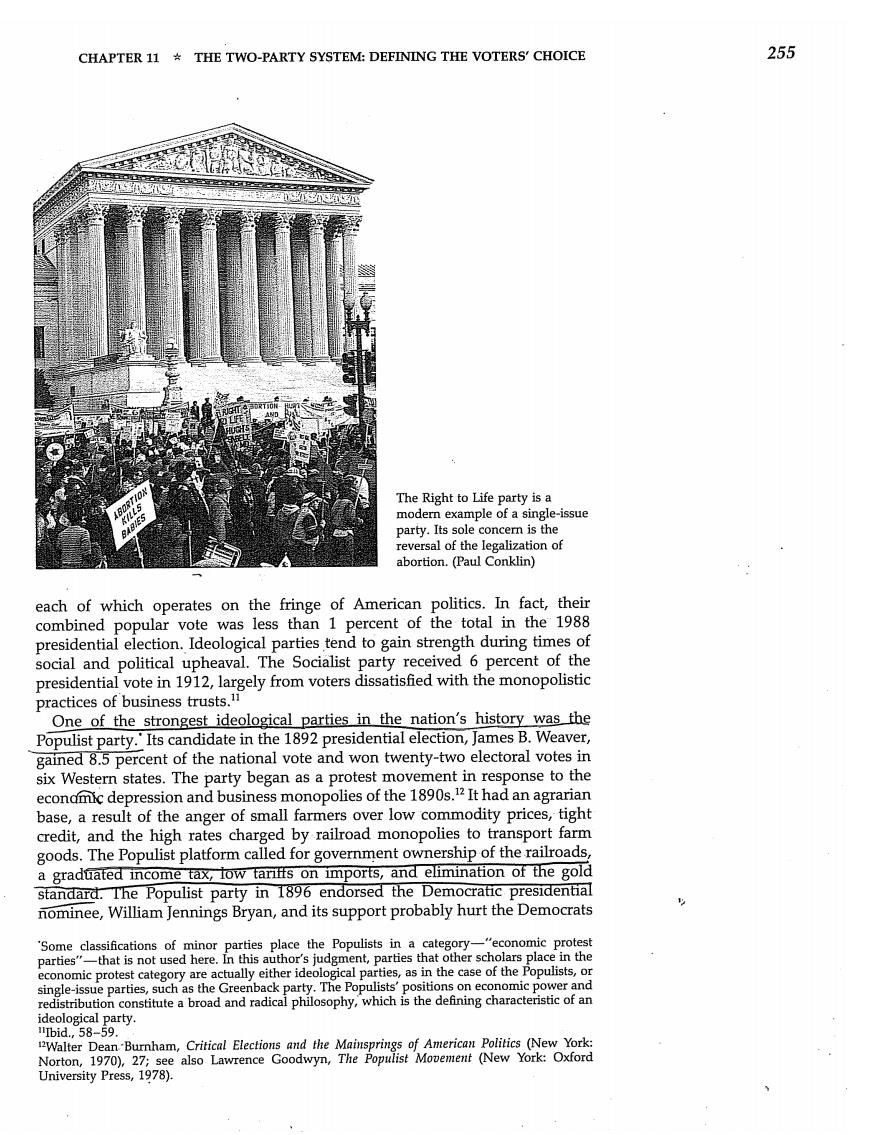
CHAPTER 11 THE TWO-PARTY SYSTEM:DEFINING THE VOTERS'CHOICE 255 The Right to Life party is a modern example of a single-issue party.Its sole concern is the reversal of the legalization of abortion.(Paul Conklin) each of which operates on the fringe of American politics.In fact,their combined popular vote was less than 1 percent of the total in the 1988 presidential election.Ideological parties tend to gain strength during times of social and political upheaval.The Socialist party received 6 percent of the presidential vote in 1912,largely from voters dissatisfied with the monopolistic practices of business trusts.11 One of the strongest ideological parties in the nation's history was the Populist party.'Its candidate in the 1892 presidential election,James B.Weaver, gained 8.5 percent of the national vote and won twenty-two electoral votes in six Western states.The party began as a protest movement in response to the econdmic depression and business monopolies of the 1890s.12 It had an agrarian base,a result of the anger of small farmers over low commodity prices,tight credit,and the high rates charged by railroad monopolies to transport farm goods.The Populist platform called for government ownership of the railroads, a graduated income tax,low tariffs on imports,and elimination of the gold standard.The Populist party in 1896 endorsed the Democratic presidential nominee,William Jennings Bryan,and its support probably hurt the Democrats 'Some classifications of minor parties place the Populists in a category-"economic protest parties"-that is not used here.In this author's judgment,parties that other scholars place in the economic protest category are actually either ideological parties,as in the case of the Populists,or single-issue parties,such as the Greenback party.The Populists'positions on economic power and redistribution constitute a broad and radical philosophy,which is the defining characteristic of an ideological party bid.,58-59. Walter Dean Burnham,Critical Elections and the Mainsprings of American Politics (New York: Norton,1970),27;see also Lawrence Goodwyn,The Populist Movement (New York:Oxford University Press,1978)
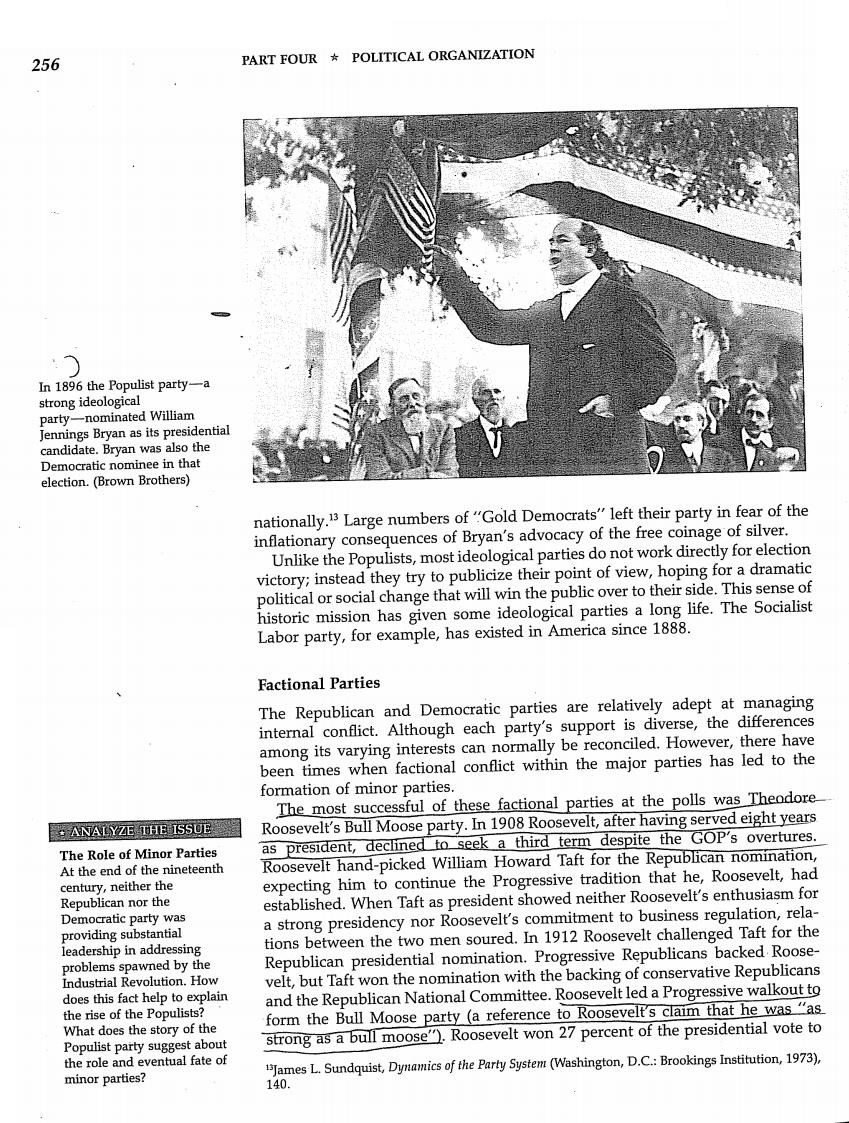
256 PART FOUR POLITICAL ORGANIZATION In 1896 the Populist party-a strong ideological party-nominated William Jennings Bryan as its presidential candidate.Bryan was also the Democratic nominee in that election.(Brown Brothers) nationally.1 Large numbers of"Gold Democrats"left their party in fear of the inflationary consequences of Bryan's advocacy of the free coinage of silver. Unlike the Populists,most ideological parties do not work directly for election victory;instead they try to publicize their point of view,hoping for a dramatic political or social change that will win the public over to their side.This sense of historic mission has given some ideological parties a long life.The Socialist Labor party,for example,has existed in America since 1888. Factional Parties The Republican and Democratic parties are relatively adept at managing internal conflict.Although each party's support is diverse,the differences among its varying interests can normally be reconciled.However,there have been times when factional conflict within the major parties has led to the formation of minor parties. The most successful of these factional parties at the polls was Theodore +AAYZ正ThE1SS0正 Roosevelt's Bull Moose party.In 1908 Roosevelt,after having served eight years The Role of Minor Parties as president,declined to seek a third term despite the GOP's overtures. At the end of the nineteenth Roosevelt hand-picked William Howard Taft for the Republican nomination, century,neither the expecting him to continue the Progressive tradition that he,Roosevelt,had Republican nor the established.When Taft as president showed neither Roosevelt's enthusiasm for Democratic party was a strong presidency nor Roosevelt's commitment to business regulation,rela- providing substantial leadership in addressing tions between the two men soured.In 1912 Roosevelt challenged Taft for the problems spawned by the Republican presidential nomination.Progressive Republicans backed Roose- Industrial Revolution.How velt,but Taft won the nomination with the backing of conservative Republicans does this fact help to explain and the Republican National Committee.Roosevelt led a Progressive walkout to the rise of the Populists? What does the story of the form the Bull Moose party(a reference to Roosevelt's claim that he was "as Populist party suggest about strong as a bull moose").Roosevelt won 27 percent of the presidential vote to the role and eventual fate of James L.Sundquist,Dynamics of the Party System(Washington,D.C.:Brookings Institution,1973), minor parties? 140